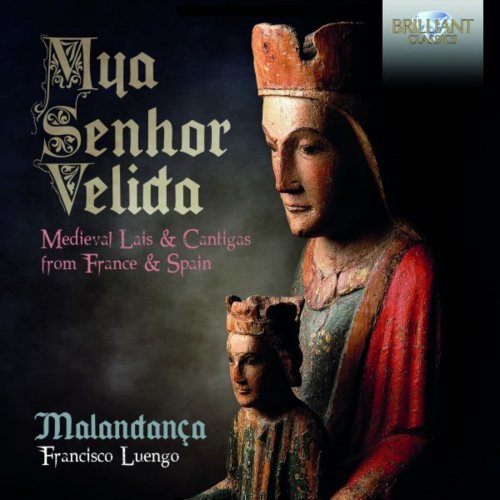
Malandanca & Francisco Luengo - Mya Senhor Velida: Medieval Lais & Cantigas from France & Spain (2018)
BAND/ARTIST: Malandanca, Francisco Luengo
- Title: Mya Senhor Velida: Medieval Lais & Cantigas from France & Spain
- Year Of Release: 2018
- Label: Brilliant Classics
- Genre: Classical
- Quality: flac lossless
- Total Time: 01:01:50
- Total Size: 353 mb
- WebSite: Album Preview
Tracklist
---------
01. Plainte de la vierge au pied de la croix
02. Santa María loei, e loo e loarei
03. Recordare. Antifona para el ofertorio en la fiesta de Maria Mediadora
04. Nembressete Madre de Deus, CSM421
05. Lai de Notre Dame
06. Virgen Madre groriosa, CSM340
These medieval cantigas and lais – troubadour compositions from Galicia and France, respectively – display an innovation of the 12th and 13th centuries: themes of courtly love and Marian devotion combined, at once carnal and mystical, encompassing both the profane and the divine.
The two lais on this recording are found in a manuscript songbook known as the Noailles Chansonnier from c.1300. In the anonymous Plainte de la Vierge au pied de la croix the Virgin Mary speaks in first person in a figurative lament at the foot of the cross. The Lai de Notre Dame, attributed to 13th-century troubadour Ernoul ‘Le Vieux’ or ‘Le Vielle’, begins with the author’s promise to keep faith with the Virgin Mary and serve no other woman, a pledge quitereminiscent of those of Alfonso X of Castile in his Cantigas de Santa Maria, one of the largest collections of monophonic songs from the Middle Ages.
The Cantigas, attributed to King Alfonso X (1221–1284), were written in early-Medieval Galician-Portuguese, fashionable as a lyrical language in Castile at the time. In Santa Maria loei, e loo e loarei, the king thanks the Virgin Mary for her kindness and protection. Nenbressete, Madre de Deus deals with Mary’s role as mediator – in medieval eyes, her primary function. It was composed as a contrafactum on Recordare (an antiphon for the offertory sung in the Feast of Mary Mediatrix, also recorded here), translating the antiphon into Galician-Portuguese and expanding it with new musical and poetic concepts.
Virgen Madre groriosa, a contrafactum on the estampie ‘Reis Glorios’ by French troubadour Giraut de Bornelh, binds this album together, demonstrating the relationship between the Galician-Portuguese and French lyrics.
To the members of Malandança, medieval music is a field in which both performance and scholarship are unavoidable and interdependent subjects. Research conducted by Francisco Luengo and others into sculptures depicting medieval instruments has opened up a world of sounds, ideas, images and voices from the distant Middle Ages.
---------
01. Plainte de la vierge au pied de la croix
02. Santa María loei, e loo e loarei
03. Recordare. Antifona para el ofertorio en la fiesta de Maria Mediadora
04. Nembressete Madre de Deus, CSM421
05. Lai de Notre Dame
06. Virgen Madre groriosa, CSM340
These medieval cantigas and lais – troubadour compositions from Galicia and France, respectively – display an innovation of the 12th and 13th centuries: themes of courtly love and Marian devotion combined, at once carnal and mystical, encompassing both the profane and the divine.
The two lais on this recording are found in a manuscript songbook known as the Noailles Chansonnier from c.1300. In the anonymous Plainte de la Vierge au pied de la croix the Virgin Mary speaks in first person in a figurative lament at the foot of the cross. The Lai de Notre Dame, attributed to 13th-century troubadour Ernoul ‘Le Vieux’ or ‘Le Vielle’, begins with the author’s promise to keep faith with the Virgin Mary and serve no other woman, a pledge quitereminiscent of those of Alfonso X of Castile in his Cantigas de Santa Maria, one of the largest collections of monophonic songs from the Middle Ages.
The Cantigas, attributed to King Alfonso X (1221–1284), were written in early-Medieval Galician-Portuguese, fashionable as a lyrical language in Castile at the time. In Santa Maria loei, e loo e loarei, the king thanks the Virgin Mary for her kindness and protection. Nenbressete, Madre de Deus deals with Mary’s role as mediator – in medieval eyes, her primary function. It was composed as a contrafactum on Recordare (an antiphon for the offertory sung in the Feast of Mary Mediatrix, also recorded here), translating the antiphon into Galician-Portuguese and expanding it with new musical and poetic concepts.
Virgen Madre groriosa, a contrafactum on the estampie ‘Reis Glorios’ by French troubadour Giraut de Bornelh, binds this album together, demonstrating the relationship between the Galician-Portuguese and French lyrics.
To the members of Malandança, medieval music is a field in which both performance and scholarship are unavoidable and interdependent subjects. Research conducted by Francisco Luengo and others into sculptures depicting medieval instruments has opened up a world of sounds, ideas, images and voices from the distant Middle Ages.
Year 2018 | Classical | FLAC / APE
As a ISRA.CLOUD's PREMIUM member you will have the following benefits:
- Unlimited high speed downloads
- Download directly without waiting time
- Unlimited parallel downloads
- Support for download accelerators
- No advertising
- Resume broken downloads


